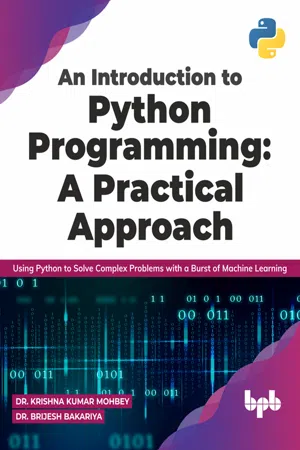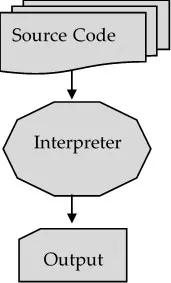
An Introduction to Python Programming: A Practical Approach
step-by-step approach to Python programming with machine learning fundamental and theoretical principles.
- English
- ePUB (mobile friendly)
- Available on iOS & Android
An Introduction to Python Programming: A Practical Approach
step-by-step approach to Python programming with machine learning fundamental and theoretical principles.
About this book
step-by-step approach to Python programming with machine learning fundamental and theoretical principles.
Key Features
? Introduces readers to Python programming in a very simple way.
? Extensive practical demonstration of Python concepts using numerous examples.
? Implementation of machine learning in Python using hands-on techniques.
Description
The book 'Introduction to Python Programming: A Practical Approach' lays out a path for readers who want to pursue a career in the field of computer software development. It covers the fundamentals of Python programming as well as machine learning principles. Students will benefit from the examples that are included with each concept, which will aid them in understanding the concept.This book provides a practical understanding of Python programming using numerous programs and examples. It also develops problem-solving and code-writing abilities for the readers. This book covers Python fundamentals, operators, and data structures such as strings, lists, dictionaries, and tuples. It also contains information on file and exception handling. The implementation of a machine learning model has also been included in this book.With the help of this book, students and programmers can improve their programming skills as well as their ability to sprint towards a rewarding career.
What you will learn
? Learn Python concepts, operators, and data structures.
? Learn the properties and operations of lists, tuples, and dictionaries.
? Write Python code to solve specific issues.
? Write Python code to handle disk files and exceptions.
? Work with OOPS properties like classes, objects, constructors, inheritance, and polymorphism.
Who this book is for
This book is intended for current and aspiring emerging technology professionals, students, and anyone else who wishes to better understand the Python programming language and machine learning concepts.
Table of Contents
1. Chapter 1: Basics of Python Programming
2. Chapter 2: Operators and Expressions
3. Chapter 3: Control Flow Statements
4. Chapter 4: Functions
5. Chapter 5: Strings
6. Chapter 6: Lists
7. Chapter 7: Tuple
8. Chapter 8: Dictionaries
9. Chapter 9: File Handling
10. Chapter 10: Exception Handling, Modules, and Packages
11. Chapter 11: Object-oriented Programming
12. Chapter 12: Machine Learning with Python
13. Chapter 13: Clustering with Python
About the Authors
Dr. Krishna Kumar Mohbey is an assistant professor of Computer Science at the Central University of Rajasthan, India. He completed his Ph.D. from the Department of Mathematics and Computer Applications from the National Institute of Technology Bhopal, India (2015). His areas of interest are machine learning, data mining, mobile web services, big data analysis, and user behavior analysis. He has authored three books on different subjects and published more than 25 research articles in reputed journals and conferences. LinkedIn Profile: https://in.linkedin.com/in/dr-k-k-mohbey-78947448 Dr. Brijesh Bakariya is working as an assistant professor for the Department of Computer Science and Engineering, I.K. Gujral Punjab Technical University (IKGPTU) Jalandhar (Punjab). He completed his Ph.D. degree from Maulana Azad National Institute of Technology (NIT- Bhopal), Madhya Pradesh (2016). He has authored 01 books and published more than 15 research papers in the journals of international repute in areas of data mining, image processing, machine learning, etc. LinkedIn Profile: https://www.linkedin.com/in/brijesh-bakariya-72b0237a
Frequently asked questions
- Essential is ideal for learners and professionals who enjoy exploring a wide range of subjects. Access the Essential Library with 800,000+ trusted titles and best-sellers across business, personal growth, and the humanities. Includes unlimited reading time and Standard Read Aloud voice.
- Complete: Perfect for advanced learners and researchers needing full, unrestricted access. Unlock 1.4M+ books across hundreds of subjects, including academic and specialized titles. The Complete Plan also includes advanced features like Premium Read Aloud and Research Assistant.
Please note we cannot support devices running on iOS 13 and Android 7 or earlier. Learn more about using the app.
Information
CHAPTER 1
Basics of Python Programming
Structure
- Basic features and history of Python
- Installing Python and running Python program to IDE
- Writing and executing first Python program
- Brief description about various concepts used in Python
Objective
Understanding Python
- Program is easier and understandable which is written in a high-level language
- Program is shorter in a high-level language
- The code written in a high-level language is portable, which means it can run on different computers with some modifications.
| Python Version | Released Year |
| 3.9 | 2020 |
| 3.8 | 2019 |
| 3.7 | 2018 |
| 3.6 | 2016 |
| 2.7 | 2010 |


- It is easy to use because its coding is written in a simple English language. Users can easily understand and write code into Python, so it takes less time to write a program.
- It is a very powerful language because it has many libraries where you can easily make a program. An inbuilt library has lots of inbuilt functions where you can insert as per your need.
- It is an object-oriented programming language that is why it follows all the object-oriented concepts.
- It is integrated with other programming languages such as C, C++, Java, etc.
- It is platform-independent, which means if you created a program in one operating system, you could also run that program in another operating system.
- It is free and open-source, which means you can install it on your computer without any cost. It can be copied or modifie...
Table of contents
- Cover Page
- Title Page
- Copyright Page
- Dedication Page
- About the Authors
- About the Reviewer
- Acknowledgement
- Preface
- Errata
- Table of Contents
- 1. Basics of Python Programming
- 2. Operators and Expressions
- 3. Control Flow Statements
- 4. Functions
- 5. Strings
- 6. Lists
- 7. Tuple
- 8. Dictionaries
- 9. File Handling
- 10. Exception Handling, Modules, and Packages
- 11. Object-oriented Programming
- 12. Machine Learning with Python
- 13. Clustering with Python
- Index